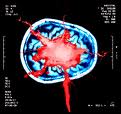How many times have we lawyers seen a sleeping juror (well – I should add – never during my presentation!)? Before a prospective juror even made it on to the jury in a criminal case in Florida, he was struck by the prosecution on the basis that he was seen sleeping during voir dire (the process of questioning prospective jurors to determine potential bias or other disqualifying information). While this is a a situation which occurs throughout the courts of this country daily, the ‘sleeping juror’ issue became the basis for an appeal in the case of Harrell v State, ___ So. 2d ___ (Fla 4th DCA – 2/24/10).
In a blog entitled “Don’t Let Sleeping Dogs Lie,” we learn that the prospective juror, a Mr. Sanders, was African-American, as was the defendant. The defense made a Neil challenge claiming that the prosecutor’s strike was impermissibly based on race. Under Florida law, it appears, “sleeping” during voir dire is a valid race-neutral reason for striking a juror — not to wake him up, but to remove him from the panel! See, Davis v. State, 560 So2d 1346 (Fla 3d DCA 1990). The trial judge’s decision to strike the juror was affirmed by the Fourth District Court of Appeal. In essence, the appellate court reasoned that that “in order for non-verbal behavior (like sleeping) to be a valid “race-neutral reason” for a strike the non-verbal behavior must meet the “hurdle” of either being observed by the trial court or being supported by the record.” 
What won the day for the prosecution was that the defendant’s argument did not even reach that ‘hurdle’ since the defendant did not adequately challenge the ‘factual basis’ of the prosecutor’s claim that the juror was sleeping. Even though none of the other lawyers or the judge saw Mr. Sanders sleeping, the appellate court ruled that because of the lack of a definitive and express dispute to the prosecutor’s observation, the issue was not, in the eyes of the court, properly preserved on appeal.
In other jury news, the ABA posted an online article about a California judge, who was picked for jury duty but who seems to have forgotten that he should not have been emailing the outside world, including his fellow jurists, about his jury duty.
 Judge James Oppliger of Fresno County sent four e-mails about his jury service to a group of more than 20 judges, according to stories in theFresno Bee, KFSN-TV and CBS47. “Here I am livin’ the dream, jury duty with Mugridge and Jenkins!” the two lawyers on the case, wrote Oppliger, who was selected to be jury foreman.
Judge James Oppliger of Fresno County sent four e-mails about his jury service to a group of more than 20 judges, according to stories in theFresno Bee, KFSN-TV and CBS47. “Here I am livin’ the dream, jury duty with Mugridge and Jenkins!” the two lawyers on the case, wrote Oppliger, who was selected to be jury foreman.
Oh, yes – one of the judges who received the emails was the judge presiding over the trial, who failed to mention he had received this ‘juror message’ until after the defendant was convicted of second degree murder. The defense lawyer was, at the time of the report, considering whether to seek a new trial based on the emails.
And finally in today’s round-up of jury stories, in January of this year, the Washington Post reported on a case involving a juror who was not certain about the definition of a word he had heard in court – “lividity.” So what did he do? What every good juror in today’s digital age would do – he looked it up in Wikipedia that evening.
A Maryland appellate court did not think this was as innocent as the juror proclaimed. 
In throwing out the defendant’s first-degree murder conviction and ordering a new trial, the court ruled that [the juror’s] inquiry violated an Anne Arundel County judge’s order prohibiting jurors from researching the case.
So, when you get called for jury duty, keep the above principles in mind: don’t email, don’t research online and by all means – don’t close your eyes during voir dire. You could be the next subject of a blog if you do.
 Everyone has, at one time or another, been offended by a relative’s hurtful comments. In the case of Sunda Croonquist’s family, however, the offended relatives were not content to let the offending comments pass without notice. As reported by ABA Journal and other outlets, the family members actually sued her. Turns out that Ms. Croonquist is a comedienne, who takes advantage of her mixed ethnicity – she is half-black and half-Swedish and is married to a Jewish man – to poke fun at her family. Apparently, the family was not laughing, especially when Ms. Croonquist publicly joked that some of them were racist. Several of Ms. Croonquist’s in-laws, including her mother-in-law, filed suit in New Jersey alleging, among other counts, defamation and infliction of emotional distress.
Everyone has, at one time or another, been offended by a relative’s hurtful comments. In the case of Sunda Croonquist’s family, however, the offended relatives were not content to let the offending comments pass without notice. As reported by ABA Journal and other outlets, the family members actually sued her. Turns out that Ms. Croonquist is a comedienne, who takes advantage of her mixed ethnicity – she is half-black and half-Swedish and is married to a Jewish man – to poke fun at her family. Apparently, the family was not laughing, especially when Ms. Croonquist publicly joked that some of them were racist. Several of Ms. Croonquist’s in-laws, including her mother-in-law, filed suit in New Jersey alleging, among other counts, defamation and infliction of emotional distress.









